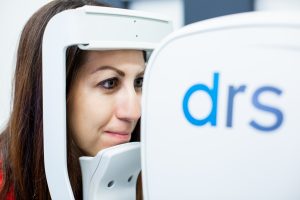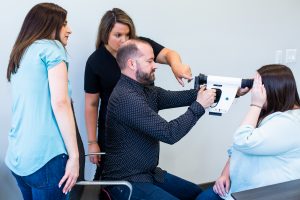Top Tips for Choosing the Best Retinal Camera: Tabletop vs. Handheld Cameras

New advances in ocular testing equipment present an opportunity for primary care providers to reduce severe vision loss, especially those cases caused by diabetic retinopathy or macular edema. By bringing effective diagnostic eye care to non-eyecare specialists, the latest retinal screening tools make early detection affordable and accessible for both patients and providers. New, innovative eye exam equipment also offers more mobility and enriched capabilities for providers to leverage, including easier travel to retinal exam sites and handheld imaging.
Choosing the best retinal imaging camera for your practice can be overwhelming, but it’s critical to effectively delivering quality care. Here are a few considerations to keep in mind as you select the best camera to fit your practice’s unique needs:
Types of Cameras
There are two common types of eye exam equipment used for retinal imaging: tabletop cameras and handheld cameras.
Tabletop Cameras
We use the term “tabletop” camera to describe cameras that sit on top of a medical instrument table. The two pieces of fully automated retinal exam equipment work hand in hand to deliver the best possible experience for both the camera operator and the patient.
Tabletop cameras tend to be more expensive than portable cameras. However, they do allow operators to take higher-quality images more consistently. Most tabletop cameras offer very high image quality and fully automatic image-capturing capabilities, contributing to ease of use and high user satisfaction.

Handheld Cameras
A handheld camera is a smaller, more portable imaging device. This tool is battery-operated and does not need a stand or table to operate. It is best suited for customers who need to be more mobile with their camera to complete their exams successfully, such as those performing fundus photography in patient homes.
Handheld cameras have come a long way in recent years. This type of imaging equipment tends to be more affordable than tabletop cameras, and it allows you to make retinal imaging more accessible to your patients. Handheld cameras are used in homes, mobile clinics, and health fairs and are often shared between remote location
s. A handheld camera also requires a smaller footprint for your clinic, allowing for increased flexibility in space.
Both handheld and tabletop cameras have been proven to be effective eye exam tools for retinal imaging. Most handheld cameras are manual, which requires a bit more practice to achieve optimal image quality. This is not a reason to forgo handheld cameras; instead, it’s a reminder to select the right tool based on the needs of your patient population and to provide your personnel with the training they need to use either camera with accuracy and efficiency.

In conclusion, handheld cameras are often best for health risk assessment companies or payors looking to provide more complete at-home care services, and tabletop cameras are better suited for healthcare provider offices, as they don’t travel well. We see comparable image quality from both solutions; the difference is the type of solution that best fits the needs of your organization. Here’s our latest webinar which teaches providers how to use both types of cameras to reach underserved patients:
The Importance of Fundus Image Quality
While price is an important consideration for selecting any imaging equipment, image quality is paramount. Being able to easily capture a high-quality image using the right equipment is critical to the effectiveness of your program.
IRIS offers a unique solution that includes proprietary image enhancement technology that helps optimize gradability. Couple this with IRIS’ historic readability rates of approximately 95% and the chance of success is very high. Once the image is captured, a licensed eye care provider can then evaluate the health of a patient’s retinas.
Staff training is also critical to ensuring high image quality. Select a service provider that offers training for your staff to ensure that your team can effectively use the camera you choose. IRIS prides itself on providing both onsite and virtual training for all camera types. Not to mention, we know that superior image quality can be achieved with each camera compatible with our software platform. At IRIS, we have a team of training experts that are ready to assist our clients whenever they need it.
The IRIS Partnership with Health Risk Assessments
These days, more and more private organizations are partnering with payor and provider clients participating in value-based care programs that perform in-home health evaluations to evaluate whole-health needs of plan members. These organizations, commonly referred to as HRAs, or Health Risk Assessment companies, find IRIS technology to be useful in improving the accessibility of patient care. Because of the ease, reliability, and portability of the IRIS solution, preventative diabetic retinopathy testing can be done as a part of an at-home care check. The fundus image is taken by the healthcare worker with a handheld portable camera and is uploaded to the IRIS cloud technology platform. It is then automatically enhanced with our proprietary enhancement technology to create a more detailed view of the retinal image. It is then sent through the cloud to the IRIS Reading Center or other licensed eye care providers, and after examination, the results are made available to the HRA.
Doing preventative testing for diabetic retinopathy straight from a patient’s home is a game changer for HRAs in their quest to close the care gap with these types of preventative screenings. It means an additional screening measure can be offered to the HRA’s health plan customers as part of the routine check an HRA provider already performs.
Furthermore, it is of paramount importance for these fundus images to have high image quality. If the images taken by a fundus camera are upgradeable, it wastes both time and money. Thus, in order for HRAs to avoid sunken costs, it is important to make image quality a priority in your quest to pick a retinal imaging camera.
Why Ease of Use is so Important
Multiple members of your staff can use new retinal screening tools, but it’s important to shorten the learning curve for them as much as possible to mitigate the go-to-market timeline. It is critically important to pick a camera that your staff will be comfortable using. Introducing a new tool can add frustration for your employees, which can ultimately counteract the effectiveness of your program. However, if they can use the tool(s) confidently, it will lead to high satisfaction and engagement in the program, quality retinal imaging, and an increase in early diagnoses of diseases that cause preventable blindness.
Tabletop cameras are typically much easier to use than handheld devices because tabletop cameras generally are fully automatic, which usually leads to more consistent quality images. A handheld camera gives users more control and portability but requires more manual effort. Because the camera needs to be aligned and focused manually, there is a steeper learning curve. However, with the help of IRIS trainers, this learning curve is lowered drastically.
In addition to the actual camera itself, software and hardware integration must be easy for users. The more proficient your staff is, the more efficiently you can incorporate retinal screening into your practice and provide high-quality results to your patients.

There are many factors to consider when choosing to invest in a retinal camera. Your selection will have a lasting impact on your organization and your patients. Leverage these considerations above to make confident decisions as you pick retinal screening tools for your camera operators and patients.
Want to learn more about what kind of eye exam equipment may fit best with your practice? Contact us to learn more!
Interested in learning more about how IRIS is innovating diabetic retinal exams? Check out our blog!
Retinal Imaging FAQs
How much are digital retinal cameras?
Retinal (fundus) cameras range dramatically in price depending on a variety of factors including field of visibility, size, and portability. Determining what your practice needs will be key in choosing a camera that meets your needs while remaining within your budget. Our team can help you choose the right camera that meets your practice’s needs – connect with us today to learn more.
What can retinal imaging detect?
Currently, retinal imaging, done by an eye care professional, has the ability to detect a host of pathologies that affect the eye, such as diabetic retinopathy, HIV retinopathy, hypertension, macular edema, epiretinal, glaucoma, cataracts, wet/dry AMD, macular hole, vein occlusion, etc. There is ongoing research exploring the possibility of using retinal screenings to detect other issues like Alzheimer’s disease.
SM036 RevB
Get started with IRIS today.
Want to know if IRIS is right for you? Schedule a one-on-one consultation with our team. We’re here to help.